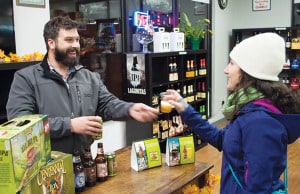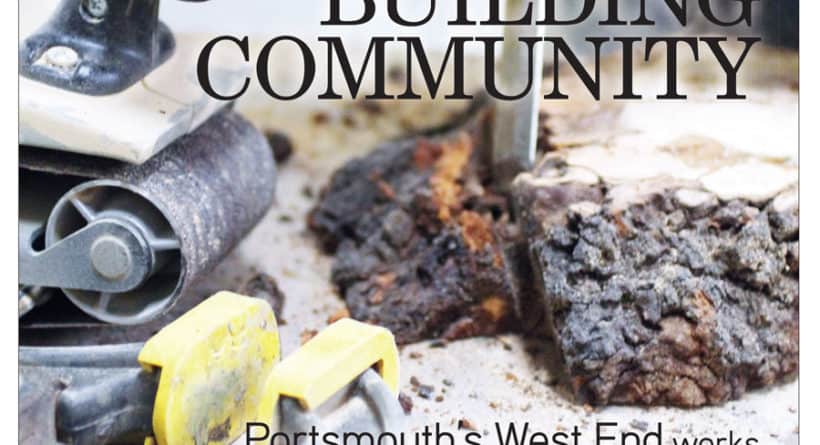When Jonathan Blakeslee was living in Portland, Ore. in the late 1990s, he watched as Alberta Street transformed from a run-down, working-class neighborhood, with nothing more notable than a few burrito shops, into a creative hub where businesses banded together.
“There was a time when it actually was a sketchy section of town where you wanted to be careful where you parked your car, but what happened is, like in a lot of places, the people that couldn’t afford to live somewhere else, maybe a more desirable part of the city, started moving to that area and doing what they could,” Blakeslee said.
Since Blakeslee returned to the Seacoast in 2005, he’s seen echoes of that Alberta Street renaissance in Portsmouth’s West End neighborhood. He moved White Heron Tea & Coffee from Rollinsford to Portsmouth and opened a café on Islington Street in 2013.
“It is just sort of interesting to see new things develop,” Blakeslee said. “And now it feels like, how do we as citizens, and customers, and all the different things that we are as part of the community, nurture the growth of something while maintaining the feel of the area?”
The West End neighborhood, a jumble of old mill buildings, restaurants, retail stores, and arts venues, reminded Blakeslee of the Portsmouth of his youth, which is why he decided to relocate.
“I like that over here we have the hardware store; around the corner, the Button Factory is full of artists creating things… It just reminded me more of Portsmouth growing up,” Blakeslee said.
While the West End has long been established, it’s undergoing its own kind of renaissance. While Market Square and downtown Portsmouth has become a magnet for tourists and a regular destination of choice for national media outlets, the West End has quietly been establishing itself as an alternative downtown for locals. It’s a place where you can pick up groceries, drop the kids off for music lessons, get dinner, and see a play, all within a few blocks. Much of that growth has happened organically. But now, Blakeslee and other business owners and non-profits are banding together to promote and guide more growth in the neighborhood.
… over here we have the hardware store; around the corner, the Button Factory is full of artists creating things… It just reminded me more of Portsmouth growing up.
A changing neighborhood
The boundaries of Portsmouth’s West End vary depending on who you ask, but the general consensus is that the neighborhood begins on Islington Street at the Discover Portsmouth Center and stretches to the new Portsmouth Music and Arts Center (PMAC) building just before the Route 1 Bypass bridge and includes all the side streets along the corridor to Middle Street.
When Sara Curry moved to the neighborhood 10 years ago and purchased Bikram Yoga Portsmouth, then located in Gallagher’s Place on Islington Street, she thought the West End “was kind of run down.” It’s heyday as a working-class neighborhood — when the Button Factory was fully operational and the Frank Jones Brewery was bottling beer — was long gone.
Russ Grazier, Jr., executive director of PMAC, grew up on Middle Street in the 1970s. Back then, it was home to doughnut shops, Burger Chef, and a string of gas stations.
“I just think that Portsmouth has kind of matured a lot, and it just seems to be a healthier environment, although it has always been a really interesting town,” Grazier said.
In the last decade, the West End has been undergoing a slow transformation. In 2004, Portsmouth Community Radio joined longtime arts venues like the Button Factory and West End Studio Theater, and in 2014, PMAC moved from a location on Albany Street to north Islington Street. New restaurants and cafes, including Street, Lexie’s Joint and White Heron Tea, opened alongside veteran neighborhood businesses like Café Espresso and Bob’s Broiled Chicken. And though the neighborhood has changed, it still maintains its old charm.
Banding businesses
Shortly after moving here, Curry joined the West End Business Association, a coalition of neighborhood business owners that met quarterly. The group provided input to the city on various projects in the area, but did little else. As the neighborhood has grown, so too has the WEBA. Now, it’s one of only two active neighborhood business associations in the city.
Blakeslee has helped instigate some of that change. After moving back to the West End, he noticed several businesses in the area were underappreciated.
“Some of us have brick and mortar businesses that are an easy public access, like where we are. The building is surf green, we serve coffee and tea and we do have some parking … but what about all of the other people, the acupuncturists and people with offices?” he said. “I started thinking if you were a West End resident, how do you know there are all these things around the corner?”
Now, West End business owners are working together to build a community. In August, they launched a monthly “Third Thursdays” event, in which neighborhood businesses, nonprofits, and artists show off what they have to offer.
On a quiet Thursday in November, the West End was bustling. At White Heron, Blakeslee taught visitors how to make organic chai, while Craft Beer Cellar offered a free tasting of a new Founders brew. At PMAC, Newmarket artist Sarah Mansfield hosted a reception for her month-long exhibit. And at Port City Makerspace, tinkerers of all levels tried out some wood-working equipment and 3-D printers.

An alternative downtown
What Blakeslee likes most about the West End is that it’s still a working-class residential neighborhood. “Something Sara and I have talked about is the idea of ‘live, work, play.’ You can actually do a lot of things in the West End that you can’t do downtown anymore,” he said.
Within walking distance of White Heron, there’s a hardware store, pharmacy, dentist’s office, grocery store, and a handful of yoga studios and restaurants. It’s a place a person could do all her errands
on foot.
Chad Callihan, co-owner of the Weekender House on Albany Street, has lived in several cities and sees the West End as a sort of second downtown.
“A lot of places have downtown and midtown and I thought this could be like the midtown or second downtown for Portsmouth,” Callihan said. “If done correctly, where you can incorporate residential, retail, walkability and accessibility, it becomes a downtown for locals.”
Affordable rents have helped, too. Port City Makerspace co-founder Clint Crosbie said that’s one of the reasons he located in the neighborhood in 2012. The South End is “packed out” and Lafayette Road is already full of developed neighborhoods, according to Crosbie. In the West End, there are still older buildings waiting for a new purpose. “We picked the West End because we wanted to be close enough to downtown … but within a price bracket we could get into,” said Crosbie.
Maintaining momentum
Maintaining the West End’s momentum means keeping the neighborhood in good repair. Curry said the city could help by moving forward on improvements to the Islington Street corridor. Though there is plenty of parking — something downtown Portsmouth lacks — the neighborhood is not exactly pedestrian-friendly. Crosswalks are difficult to see, sidewalks are inconsistent and about 18,000 cars pass down the street each day, most unaccustomed to having pedestrians in the area, Curry said.
The city has been eying the Islington Street corridor for improvements since the late 1990s, but implementation has been slow. A traffic study focused on existing conditions along Islington Street from Maplewood Avenue to Spinney Road was completed in 1997,

